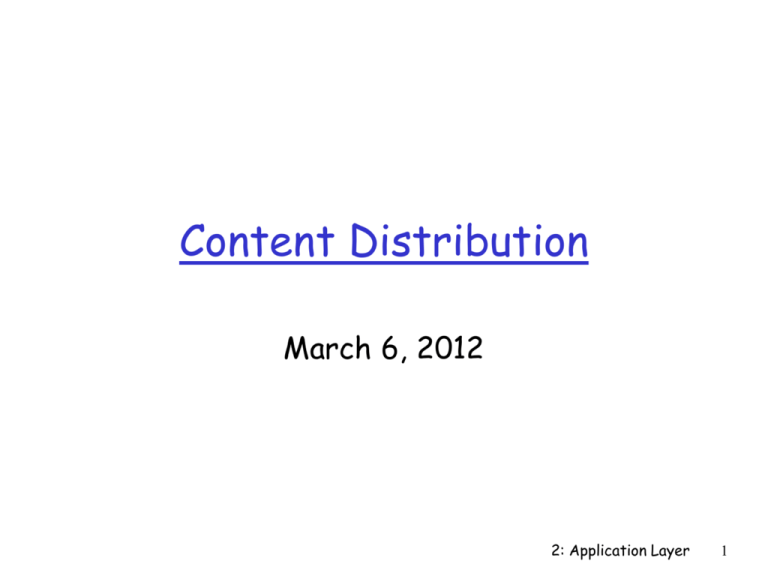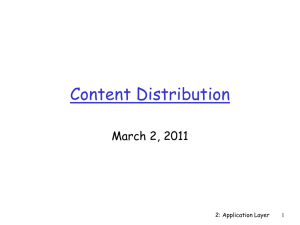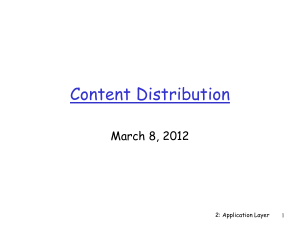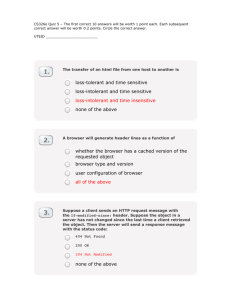Content Distribution
advertisement

Content Distribution
March 6, 2012
2: Application Layer
1
Contents
P2P architecture and benefits
P2P content distribution
Content distribution network (CDN)
2: Application Layer
2
Pure P2P architecture
no always-on server
arbitrary end systems
directly communicate peer-peer
peers are intermittently
connected and change IP
addresses
Three topics:
File distribution
Searching for information
Case Study: Skype
2: Application Layer
3
File Distribution: Server-Client vs P2P
Question : How much time to distribute file
from one server to N peers?
us: server upload
bandwidth
Server
us
File, size F
dN
uN
u1
d1
u2
ui: peer i upload
bandwidth
d2
di: peer i download
bandwidth
Network (with
abundant bandwidth)
2: Application Layer
4
File distribution time: server-client
server sequentially
sends N copies:
NF/us time
client i takes F/di
time to download
Server
F
us
dN
u1 d1 u2
d2
Network (with
abundant bandwidth)
uN
Time to distribute F
to N clients using
= dcs = max {NF/us, F/min(di) }
i
client/server approach
increases linearly w.r.t. N (for large N)
2: Application Layer
5
File distribution time: P2P
Server
server must send one
F
u1 d1 u2
d2
copy: F/us time
us
client i takes F/di time
Network (with
dN
to download
abundant bandwidth)
uN
NF bits must be
downloaded (aggregate)
fastest possible upload rate: us + Sui
dP2P = max { F/us, F/min(di) , NF/(us + Sui) }
i
2: Application Layer
6
Server-client vs. P2P: example
Client upload rate = u, F/u = 1 hour, us = 10u, dmin ≥ us
Minimum Distribution Time
3.5
P2P
3
Client-Server
2.5
2
1.5
1
0.5
0
0
5
10
15
20
25
30
35
N
Client server ~ NF/us vs. P2P ~ NF/(us +
Sui)
2: Application Layer
7
Contents
P2P architecture and benefits
P2P content distribution
Content distribution network (CDN)
2: Application Layer
8
P2P content distribution issues
Issues
Group management and data search
Reliable and efficient file exchange
Security/privacy/anonymity/trust
Approaches for group management and
data search (i.e., who has what?)
Centralized (e.g., BitTorrent tracker)
Unstructured (e.g., Gnutella)
Structured (Distributed Hash Tables [DHT])
2: Application Layer
9
Centralized model (Napster)
original “Napster” design
1) when peer connects, it
informs central server:
Bob
centralized
directory server
1
peers
IP address
content
2) Alice queries for “Hey
Jude”; server notifies
that Bob has the file..
3) Alice requests file from
Bob
1
3
1
2
Q: “Hey Jude”
A: Bob has it
1
Alice
2: Application Layer
10
Centralized model
Bob
Alice
file transfer is
decentralized, but
locating content is
highly centralized
Judy
Jane
2: Application Layer
11
Centralized model
Benefits:
Low per-node state
Limited bandwidth usage
Short search time
High success rate
Fault tolerant
Drawbacks:
Single point of failure
Limited scale
Possibly unbalanced load
Bob
Judy
Alice
Jane
copyright infringement (?)
2: Application Layer
12
File distribution: BitTorrent
P2P file distribution
tracker: tracks peers
participating in torrent
torrent: group of
peers exchanging
chunks of a file
obtain a list
of peers
trading
chunks
peer
2: Application Layer
13
BitTorrent (1)
file divided into 256KB chunks.
peer joining torrent:
has no chunks, but will accumulate them over time
registers with tracker to get list of peers,
connects to subset of peers (“neighbors”)
while downloading, peer uploads chunks to other
peers.
peers may come and go
once peer has entire file, it may (selfishly) leave or
(altruistically) remain
2: Application Layer
14
BitTorrent (2)
Pulling Chunks
at any given time,
different peers have
different subsets of
file chunks
periodically, a peer
(Alice) asks each
neighbor for a list of
chunks that it has.
Alice sends requests
for her missing chunks
rarest first
Sending Chunks: tit-for-tat
Alice sends chunks to four
neighbors currently
sending her chunks at the
highest rate
re-evaluate top 4 every
10 secs
every 30 secs: randomly
select another peer,
starts sending chunks
newly chosen peer may
join top 4
“optimistically unchoke”
2: Application Layer
15
BitTorrent: Tit-for-tat
(1) Alice “optimistically unchokes” Bob
(2) Alice becomes one of Bob’s top-four providers; Bob reciprocates
(3) Bob becomes one of Alice’s top-four providers
With higher upload rate,
can find better trading
partners & get file faster!
2: Application Layer
16
P2P Case study: Skype
Skype clients (SC)
inherently P2P: pairs of
users communicate.
proprietary
Skype
login server
application-layer
protocol (inferred via
reverse engineering)
hierarchical overlay
with super nodes (SNs)
Index maps usernames
to IP addresses;
distributed over SNs
Supernode
(SN)
2: Application Layer
17
Peers as relays
Problem when both
Alice and Bob are
behind “NATs”.
NAT prevents an outside
peer from initiating a call
to insider peer
Solution:
Using Alice’s and Bob’s
SNs, Relay is chosen
Each peer initiates
session with relay.
Peers can now
communicate through
NATs via relay
2: Application Layer
18
Contents
P2P architecture and benefits
P2P content distribution
Content distribution network (CDN)
2: Application Layer
19
Why Content Networks?
More hops between client and Web server
more congestion!
Same data flowing repeatedly over links
between clients and Web server
C1
C3
C4
S
C2
Slides from http://www.cis.udel.edu/~iyengar/courses/Overlays.ppt
- IP router
2: Application Layer
20
Why Content Networks?
Origin server is bottleneck as number of
users grows
Flash Crowds (for instance, Sept. 11)
The Content Distribution Problem: Arrange
a rendezvous between a content source at
the origin server (www.cnn.com) and a
content sink (us, as users)
Slides from http://www.cis.udel.edu/~iyengar/courses/Overlays.ppt
2: Application Layer
21
Example: Web Server Farm
Simple solution to the content distribution problem: deploy a
large group of servers
www.cnn.com
(Copy 1)
www.cnn.com
(Copy 2)
Request from
grad.umd.edu
www.cnn.com
(Copy 3)
Request from
ren.cis.udel.edu
L4-L7 Switch
Request from
ren.cis.udel.edu
Request from
grad.umd.edu
Arbitrate client requests to servers using an “intelligent”
L4-L7 switch
Pretty widely used today
2: Application Layer
22
Example: Caching Proxy
Majorly motivated by ISP business interests – reduction in
bandwidth consumption of ISP from the Internet
Reduced network traffic
Reduced user perceived latency
ISP
Client
ren.cis.udel.edu
Client
merlot.cis.ud
el.edu
Intercepters
TCP port 80
traffic
Other
traffic
Internet
www.cnn.com
Proxy
2: Application Layer
23
But on Sept. 11, 2001
Web Server
www.cnn.com
New Content
WTC News!
1000,000
other hosts
request
1000,000
other hosts
ISP
old
content
request
User
mslab.kaist.ac.kr
- Congestion /
Bottleneck
- Caching Proxy
2: Application Layer
24
Problems with discussed approaches:
Server farms and Caching proxies
Server farms do nothing about problems due to
network congestion
Caching proxies serve only their clients, not all
users on the Internet
Content providers (say, Web servers) cannot rely
on existence and correct implementation of
caching proxies
Accounting issues with caching proxies.
For instance, www.cnn.com needs to know the number of
hits to the webpage for advertisements displayed on the
webpage
2: Application Layer
25
Again on Sept. 11, 2001 with CDN
Web Server
www.cnn.com
New Content
WTC News!
WA
CA
MI
1000,000
other users
IL
MA
1000,000
other users
FL
NY
DE
request
new
content
User
mslab.kaist.ac.kr
- Distribution
Infrastructure
- Surrogate
2: Application Layer
26
Web replication - CDNs
Overlay network to distribute content from
origin servers to users
Avoids large amount of same data repeatedly
traversing potentially congested links on the
Internet
Reduces Web server load
Reduces user perceived latency
Tries to route around congested networks
2: Application Layer
27
CDN vs. Caching Proxies
Caches are used by ISPs to reduce bandwidth
consumption, CDNs are used by content providers
to improve quality of service to end users
Caches are reactive, CDNs are proactive
Caching proxies cater to their users (web clients)
and not to content providers (web servers), CDNs
cater to the content providers (web servers) and
clients
CDNs give control over the content to the content
providers, caching proxies do not
2: Application Layer
28
CDN Architecture
Origin
Server
CDN
Request
Routing
Infrastructure
Distribution
& Accounting
Infrastructure
Surrogate
Surrogate
Client
Client
2: Application Layer
29
CDN Components
Distribution Infrastructure:
Moving or replicating content from content source
(origin server, content provider) to surrogates
Request Routing Infrastructure:
Steering or directing content request from a client to
a suitable surrogate
Content Delivery Infrastructure:
Delivering content to clients from surrogates
Accounting Infrastructure:
Logging and reporting of distribution and delivery activities
2: Application Layer
30
Server Interaction with CDN
www.cnn.com
1.
Origin server pushes new
content to CDN
OR
CDN pulls content from origin
server
Origin
Server
1
2
2. Origin server requests logs and
other accounting info from CDN
OR
CDN provides logs and other
accounting info to origin server
CDN
Distribution
Infrastructure
Accounting
Infrastructure
2: Application Layer
31
Client Interaction with CDN
1. Hi! I need www.cnn.com/sept11
2.
Go to surrogate
newyork.cnn.akamai.com
CDN
california.cnn.akamai.com
Surrogate
(CA)
Request
Routing
Infrastructure
3. Hi! I need content /sept11
newyorkcnn.akamai.com
Q:
How did the CDN choose the New
York surrogate over the California
surrogate ?
Surrogate
(NY)
1
2
3
Client
2: Application Layer
32
Request Routing Techniques
Request routing techniques use a set of
metrics to direct users to “best” surrogate
Proprietary, but underlying techniques
known:
DNS based request routing
Content modification (URL rewriting)
Anycast based (how common is anycast?)
URL based request routing
Transport layer request routing
Combination of multiple mechanisms
2: Application Layer
33
DNS based Request-Routing
Common due to the ubiquity of DNS
as a directory service
Specialized DNS server inserted in
a DNS resolution process
DNS server is capable of returning
a different set of A, NS or CNAME
records based on policies/metrics
2: Application Layer
34
DNS based Request-Routing
Q: How does the Akamai
DNS know which
surrogate is closest ?
Akamai
CDN
newyork.cnn.akamai.com
Surrogate
145.155.10.15
www.cnn.com
Akamai DNS
california.cnn.akamai.com
Surrogate
58.15.100.152
1) DNS query:
www.cnn.com
test.nyu.edu
128.4.30.15
DNS response:
A 145.155.10.15
newyork.cnn.akamai.com
local DNS server (dns.nyu.edu)
128.4.4.12
2: Application Layer
35
DNS based Request-Routing
www.cnn.com
Akamai
CDN
Akamai DNS
Surrogate
Surrogate
DNS query
test.nyu.edu
128.4.30.15
local DNS server
(dns.nyu.edu)
128.4.4.12
2: Application Layer
36
DNS based Request-Routing
www.cnn.com
Akamai DNS
Akamai
CDN
Requesting DNS - 76.43.32.4
Surrogate - 145.155.10.15
Surrogate
58.15.100.152
Surrogate
145.155.10.15
Requesting DNS - 76.43.32.4
Requesting DNS - 76.43.32.4
Available Bandwidth = 10 kbps
RTT = 10 ms
Client
Client DNS
76.43.35.53
76.43.32.4
Available Bandwidth = 5 kbps
RTT = 100 ms
www.cnn.com
A 145.155.10.15
TTL = 10s
2: Application Layer
37
DNS based Request Routing: Discussion
Originator Problem: Client may be far removed
from client DNS
Client DNS Masking Problem: Virtually all DNS
servers, except for root DNS servers honor
requests for recursion
Q: Which DNS server resolves a request for test.nyu.edu?
Q: Which DNS server performs the last recursion of the
DNS request?
Hidden Load Factor: A DNS resolution may result
in drastically different load on the selected
surrogate – issue in load balancing requests, and
predicting load on surrogates
2: Application Layer
38
Summary
P2P architecture and its benefits
P2P content distribution
BitTorrent, Skype
Content distribution network (CDN)
DNS-based request routing
2: Application Layer
39
Distributed Hash Table (DHT)
DHT = distributed P2P database
Database has (key, value) pairs;
key: ss number; value: human name
key: content type; value: IP address
Peers query DB with key
DB returns values that match the key
Peers can also insert (key, value) peers
2: Application Layer
40
DHT Identifiers
Assign integer identifier to each peer in range
[0,2n-1].
Each identifier can be represented by n bits.
Require each key to be an integer in same range.
To get integer keys, hash original key.
eg, key = h(“Led Zeppelin IV”)
This is why they call it a distributed “hash” table
2: Application Layer
41
How to assign keys to peers?
Central issue:
Assigning (key, value) pairs to peers.
Rule: assign key to the peer that has the
closest ID.
Convention in lecture: closest is the
immediate successor of the key.
Ex: n=4; peers: 1,3,4,5,8,10,12,14;
key = 13, then successor peer = 14
key = 15, then successor peer = 1
2: Application Layer
42
Chord (a circular DHT) (1)
1
3
15
4
12
5
10
8
Each peer only aware of immediate successor
and predecessor.
“Overlay network”
2: Application Layer
43
Chord (a circular DHT) (2)
O(N) messages
on avg to resolve
query, when there
are N peers
0001
I am
Who’s resp
0011
for key 1110 ?
1111
1110
0100
1110
1110
1100
1110
1110
Define closest
as closest
successor
1010
0101
1110
1000
2: Application Layer
44
Chord (a circular DHT) with Shortcuts
1
3
15
Who’s resp
for key 1110?
4
12
5
10
8
Each peer keeps track of IP addresses of predecessor,
successor, short cuts.
Reduced from 6 to 2 messages.
Possible to design shortcuts so O(log N) neighbors, O(log
N) messages in query
2: Application Layer
45
Peer Churn
1
•To handle peer churn, require
3
15
4
12
5
10
each peer to know the IP address
of its two successors.
• Each peer periodically pings its
two successors to see if they
are still alive.
8
Peer 5 abruptly leaves
Peer 4 detects; makes 8 its immediate successor;
asks 8 who its immediate successor is; makes 8’s
immediate successor its second successor.
What if peer 13 wants to join?
2: Application Layer
46







